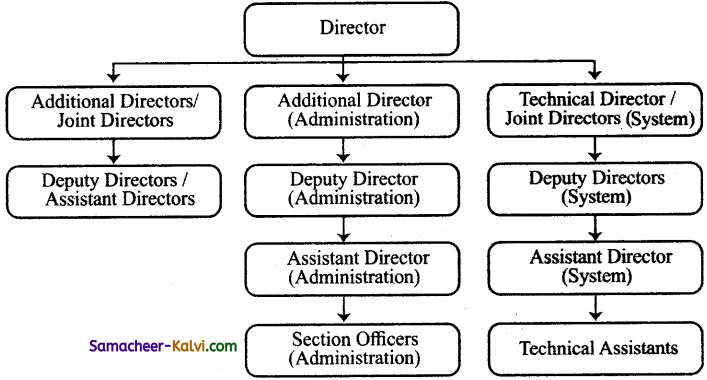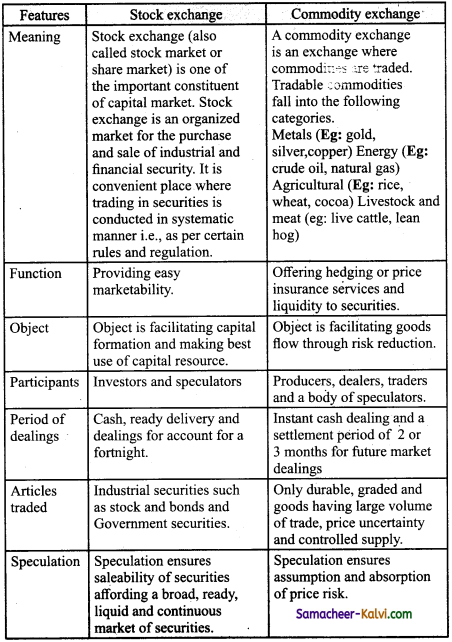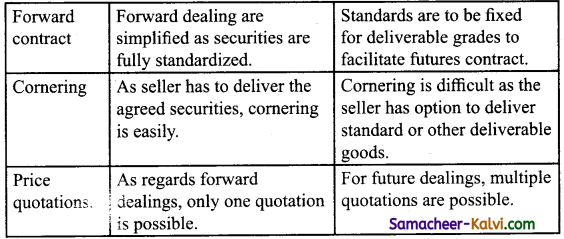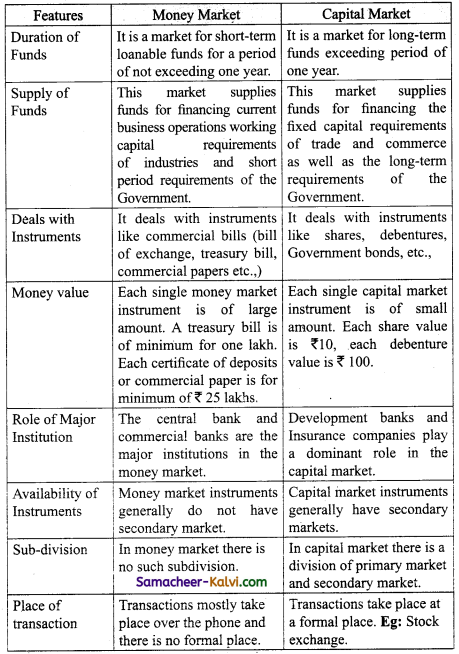TN State Board Kalvi 12th Commerce Notes Chapter 15 Recent Trends in Marketing
Question 1.
What is E – business?
Answer:
- Sale of goods undertaken with an objective of earning profit and acquiring wealth through the satisfaction of Human wants is known as business.
- All the business transaction carried out through internet and other online tools is called E-business, (internet, intranets and extranets).
Question 2.
What is green marketing?
Answer:
- Green marketing implies marketing environmentally friendly products.
- It refers to holistic marketing concept with growing awareness about the implications of global-warming, non-biodegradable, solid waste, harmful impact of pollutants etc.
- It is also known as environmental marketing, ecological, eco friendly and sustainable marketing.
Question 3.
What is service marketing?
Answer:
A service is any activity or benefit that one party can offer to another which is essentially intangible and which does not result in the ownership of anything like business, professional service, insurance legal service, medical services etc.
![]()
Question 4.
Define E-Marketing.
Answer:
According to Judy Strauss, “E-Marketing refers to application of broad range of information technology for creating more customer value through more effective segmentation targeting planning more efficiently executing the conception, distribution promotion, pricing of goods and services and creating exchanges that satisfy individual consumer and organizations consumer objectives”.
Question 5.
What is E-Tailing?
Answer:
- E-tailing or electronic retailing refers to selling of goods and services through a shopping website (internet) or through virtual store to the ultimate consumer.
- The customer buys the product by paying through credit card or other methods mentioned at the shopping website.
- E-tailing is also called online retailing.
Question 6.
What is Social marketing?
Answer:
- Systematic application of marketing philosophy and techniques to achieve specific behavioural goals which ensure social good.
- It promotes the consumption of socially desirable products and develops health consciousness.
- It helps to eradicate social evils that affect the society and quality of life.
![]()
Question 7.
What is B2B and B2C type of E-Commerce?
Answer:
B2B E-Commerce:
- This model focuses on providing products from one business to another.
- To find software company office furniture and supply companies document hosting companies and other E-Commerce business.
- The business have customer enterprise e-commerce platforms that work directly with other business in a closed environment.
B2C E-Commerce:
- B2C sales are the traditional retail model where a business sell to individuals but business is conducted online.
- The B2C model works by retailers and marketers that use clear data in various marketing tools, so can sell their products to the internet-users.
Question 8.
Explain the importance of social marketing.
Answer:
- Social marketing promotes the consumption of socially desirable products.
- To develop health consciousness.
- It helps to eradicate social evils that affect the society and quality of life.
- To achieve specific behavioural goals which ensure social good.
- It raises the living standard of the people in the society.
- Developing the products that benefit society in long run and satisfies consumers.
![]()
Question 9.
Discuss the objectives E-Marketing.
Answer:
The following are the objectives of E-Marketing.
- Expansion of market share.
- Reduction of distribution and promotional expenses.
- Achieving higher brand awareness.
- Strengthening database.
Question 10.
Elucidate how E-Commerce differs from E-Business.
Answer:
E-Commerce:
- E-Commerce refers to the buying and selling of product and services through online.
- E-Commerce is a major component of e-business.
- E-Commerce includes transactions which are related to money.
- E-Commerce requires a website that can represent the business.
E-Business:
- Buying and selling of goods and service and much wider range of business processes.
- Electronic business via web, internets, intranets, extranets and other online tool.
- It includes monetary as well as allied activities.
- It requires supply chain management electronic order processing and customer relationship management.
![]()
Question 11.
Explain in detail about Niche marketing.
Answer:
- Niche marketing denotes a strategy of directing all marketing efforts towards one well defined segment of the population.
- It is found by company, by identifying the need of customers which are not served or under served by the competitors.
- The company which identified niche market develops solution to satisfy the needs of niche market.
- It aimed at being a big fish in a small pond instead of being a small fish in a big pond.
Question 12.
Explain in detail how traditional marketing differ from E-marketing.
Answer:
| E – Marketing |
Traditional Marketing |
| It is very economical and faster way to promote the products. | It is very expensive and takes more time to promote product. |
| It is quiet easier for promoting product globally in the short time. | It is very expensive and time consuming to promote product/ service under traditional marketing. |
| E – Business enterprises can expand their operation with minimum manpower. | It needs more man power. |
| In this marketing product can be traditional sold or bought 24 × 7, round year with minimum manpower. | That is not possible in the marketing. |
![]()
Question 13.
Explain advantages and disadvantages of E-tailing.
Answer:
E-Tailing refers to selling of goods and services through a shopping website (internet) or through virtual store to the ultimate consumer.
Advantage of E-tailing:
- Customer can shop from the comfort of their homes at anytime of the day.
- Infrastructure costs are less for electronic retailing versus physical
location retail sales. - Companies can move products faster and reach a larger customers base online than the traditional physical locations.
Disadvantage of E-tailing:
- Creating and maintaining an E-tailing website can be expensive and required specialized technology skills.
- Infrastructure cost can be substantial.
- Consumers may have lack of trust shopping on an E-tailers website.
Question 14.
Describe the various strategies pursued in recent day’s marketers.
Answer:
- Developing plans and strategies for marketing today is most challenging it.
- Increasing choice of interactive devices platforms, and channels that potential customer use from smart phones, Tablets to social networks and Traditional Channel T.V, Print and Radio essential part of integrated campaigns to many business.
- Improve knowledge of marketing strategy and planning and educating the consumers.
- Voice search most rapidly adopted technologies and changing the way consumer interact with world around them.
- Marketer should ensure the main voice providers Google, Apple, Microsoft have the correct facts about their business.
- Virtual marketing is the users to pass on a marketing message to other users creating a potentially, exponential growth in the messages visibility
and effect. Hotmail Company owned by Microsoft promote the services and advertisement message instantly. - Videos on YouTube which are then shared Facebook, Twitter and other channels.
![]()
Question 15.
Compare the concept of social marketing with service marketing.
Answer:
Social Marketing:
- Social Marketing promotes the consumption of socially desirable products.
- To develop health consciousness.
- It helps to eradicate social evils that affect the society and quality of life.
- To achieve specific behavioural goals which ensure social good.
Service Marketing:
- A service is any activity or benefit that one patty can offer to another which is essentially intangible and which does not result in the ownership of anything.
- Service marketing is specialized branch of marketing.
- Service marketing denotes the processing of selling service goods like banking, insurance, health care, tourism and professional services etc..
- The unique characteristics of service marketing warrant different strategies compared with the marketing of physical goods.
Question 16.
Discuss any two new methods of marketing with it’s advantages.
Answer:
(i) Referral marketing is the method of promoting products or services to new customers through referrals. It refer to spreading the word about a product or service through existing customers of business enterprises.
(ii) Word of mouth marketing which occurs when others tell each other about a business is also considered to be a form of referral marketing. Content marketing is said to be the art of communicating with customers and prospects without selling.
Advantage:
- Growth, expansion long term success.
- Valuable resource through prospects.
- Do the things faster, easier and less expensive.
- Adding new information on your website selling opportunity prospects.
- Adding new product or service – create an opportunity to get more sales.
![]()
Choose the correct answer:
Question 1.
Selling goods/ services through internet is:
(a) Green marketing
(b) E- business
(c) Social marketing
(d) Meta marketing
Answer:
(b) E- business
Question 2.
Which is gateway to internet?
(a) Portal
(b) CPU
(c) Modem
(d) Webnaire
Answer:
(c) Modem
Question 3.
Which one represents a cluster of manufacturers, content providers and online retailers organised around an activity?
(a) Virtual mall
(b) Association
(c) Metomediary
(d) Portal
Answer:
(c) Metomediary
![]()
Question 4.
Social marketing deals with:
(a) Society
(b) Social Class
(c) Social change
(d) Social evil
Answer:
(c) Social change
Question 5.
Effective use of Social media marketing increase conversion rates of:
(a) Customer to buyers
(b) Retailer to customers
(c) One buyer to another buyer’s
(d) Direct contact of marketer
Answer:
(a) Customer to buyers
Question 6.
A company’s products and prices is visually represented by:
(a) Shopping cart
(b) Web portal
(c) Electronic catalogue
(d) Revenue model
Answer:
(c) Electronic catalogue
![]()
Question 7.
Green Shelter concept was introduced by group:
(a) ACME
(b) Tata
(c) Reliance
(d) ICI
Answer:
(a) ACME
Question 8.
Pure play retailers are called:
(a) Market creators
(b) Transaction brokers
(c) Merchants
(d) Agents
Answer:
(b) Transaction brokers




